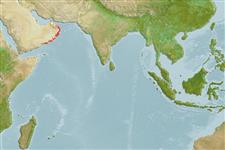Actinopterygii (ray-finned fishes) >
Perciformes (Perch-likes) >
Pomacentridae (Damselfishes) > Amphiprioninae
Etymology: Amphiprion: Greek, amphi = on both sides + Greek, prion, -onos = saw (Ref. 45335).
Environment / Climate / Range
Ecology
Marine; reef-associated; non-migratory; depth range 2 - 10 m (Ref. 7247). Tropical, preferred ?; 25°N - 16°N, 53°E - 60°E
Western Indian Ocean: known only from the Arabian Sea coast of Oman.
Size / Weight / Age
Maturity: Lm ? range ? - ? cm
Max length : 14.0 cm TL male/unsexed; (Ref. 9710)
Dorsal
spines
(total): 10;
Dorsal
soft rays
(total): 10-17;
Anal
spines: 2;
Anal
soft rays: 14 - 15. Distinctive features include overall dark brown coloration with blackish pelvic and anal fins, very narrow white bars, and blackish caudal fin in juveniles which fades with growth. The white bar on the head is usually constricted across nape; the midbody bar does not extend on to the dorsal fin.
Adults inhabit inshore reefs; information on host anemone species lacking (Ref. 7247). Oviparous, distinct pairing during breeding (Ref. 205). Eggs are demersal and adhere to the substrate (Ref. 205). Males guard and aerate the eggs (Ref. 205).
Life cycle and mating behavior
Maturity | Reproduction | Spawning | Eggs | Fecundity | Larvae
Oviparous, distinct pairing during breeding (Ref. 205). Eggs are demersal and adhere to the substrate (Ref. 205). Males guard and aerate the eggs (Ref. 205). Also Ref. 7471.
Allen, G.R., 1991. Damselfishes of the world. Mergus Publishers, Melle, Germany. 271 p. (Ref. 7247)
IUCN Red List Status (Ref. 115185)
CITES (Ref. 94142)
Not Evaluated
Threat to humans
Harmless
Human uses
More information
ReferencesAquacultureAquaculture profileStrainsGeneticsAllele frequenciesHeritabilityDiseasesProcessingMass conversion
Tools
Special reports
Download XML
Internet sources
Estimates of some properties based on models
Phylogenetic diversity index (Ref.
82805): PD
50 = 0.5000 [Uniqueness, from 0.5 = low to 2.0 = high].
Bayesian length-weight: a=0.02239 (0.01012 - 0.04954), b=2.99 (2.79 - 3.19), in cm Total Length, based on LWR estimates for this (Sub)family-body shape (Ref.
93245).
Trophic Level (Ref.
69278): 2.7 ±0.3 se; Based on size and trophs of closest relatives
Resilience (Ref.
69278): High, minimum population doubling time less than 15 months (Preliminary K or Fecundity.).
Vulnerability (Ref.
59153): Low to moderate vulnerability (25 of 100) .
